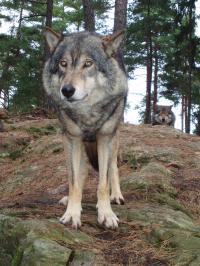In the world of wolves and ungulates - does habitat matter?
Most of the studies on feeding ecology of wolves have been conducted in North America, but several studies in many other parts of the northern hemisphere have also been made, for example in Scandinavia. In these studies, the major concern has been the patterns of predation by wolves, i.e. prey selection and its effects on prey populations.
Wolves (Canis lupus) are known to prey on a variety of different animal species and in most areas ungulates are by far the most important prey. Wolves are often argued to be selective in their search for prey, i.e. there is a disproportional predation on different prey species and individuals. Moose (Alces alces) are often the primary prey species in the northern boreal regions.
Forest management practices have often led to forest fragmentation. Due to this fact one of the hypothesized outcomes of this fragmentation is the exposure of animals to increased predation. The travel and searching efficiency of large carnivores is thought to be enhanced, as logging reduces the size of residual forest patches and increases the density of roads. Little research has been done so far on the effects in large mammal predator–prey systems of habitat alternation. In order to meet objectives for populations of both predators and prey, more knowledge of how habitat and spatial factors may affect the vulnerability of prey is needed and will provide wildlife managers with knowledge how to manage habitats and landscapes in the most efficient way.
Due to several factors, such as absence of natural predators, changes in forestry practice and harvest strategies, the Scandinavian moose and roe-deer (Capreolus capreolus) populations have experienced a dramatic growth during the last 50 years. Economically, moose became an important species, both for hunters and for forestry production. This started a debate about how to regulate and manage the moose population. The size of the moose and roe deer populations is today mainly regulated by human harvest.
The aim of this thesis was to examine if moose and roe-deer are killed with a higher frequency in some types of habitats within Scandinavian wolf territories compared with other parts in the same wolf territory.
A word of thanks to Grimsö Wildlife Research Station and Skandulv for the financial support!
Responsible for this page:
Director of undergraduate studies Biology
Last updated:
05/17/07

